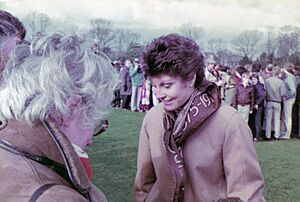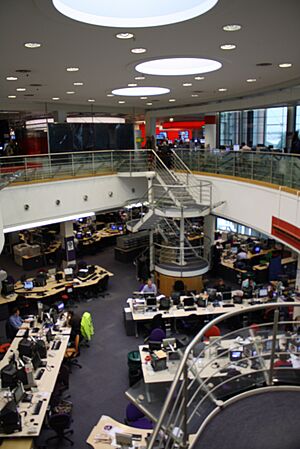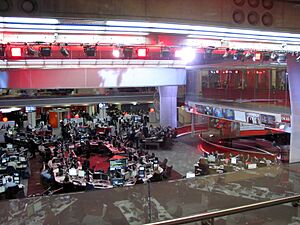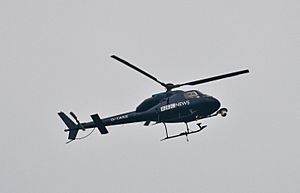BBC News facts for kids

Logo used since 2022
|
|
| Division | |
| Industry | Broadcast media |
| Founded | 14 November 1922 |
| Headquarters | Broadcasting House,
London
|
|
Area served
|
Specific services for United Kingdom and rest of world |
|
Key people
|
|
| Services | Radio, internet, and television broadcasts |
|
Number of employees
|
7,000 (5,500 journalists) |
| Parent | BBC |
| Divisions |
|
BBC News is a big part of the British Broadcasting Corporation. It is in charge of finding and sharing news and current events in the UK and all over the world. It is the largest news organization that broadcasts news globally. Every day, BBC News creates about 120 hours of radio and TV shows. It also provides lots of news online.
More than 5,500 journalists work for BBC News. They are based in 50 different news offices around the world. Over 250 foreign correspondents (reporters who work in other countries) are stationed there. Deborah Turness has been the main leader of news and current affairs since September 2022.
In 2019, a report showed that the BBC spent £136 million on news. The main news offices for the UK, global, and online news are in Broadcasting House in central London. This is the biggest live newsroom in Europe. News about Parliament is made and broadcast from studios in London. The BBC also has local news centers across England, Northern Ireland, Scotland, and Wales. These centers create their own local news, current affairs, and sports programs.
The BBC is a special organization that works independently from the government. It has a royal charter, which means it can make its own decisions about news.
History of BBC News
Early Years of News Broadcasting
The British Broadcasting Company first shared news on the radio on November 14, 1922. This was from a radio station called 2LO. At first, newspaper companies did not want the BBC to broadcast news. They convinced the government to stop the BBC from sharing news before 7 PM. The BBC also had to use news from other agencies instead of reporting its own stories.
Over time, the BBC slowly gained the right to change the news it received. In 1934, it started its own news team. However, it could not broadcast news before 6 PM until World War II. Besides radio news, cinema newsreels (short news films shown in cinemas) were broadcast on TV from 1936. The BBC started its own TV newsreel show called Television Newsreel in January 1948.
A weekly Children's Newsreel began on April 23, 1950. About 350,000 TV sets watched it. The BBC also started showing its radio news on TV in 1946. It would show a still picture of Big Ben while the radio news played. Live TV news bulletins began on July 5, 1954. These were broadcast from studios in Alexandra Palace in London.
People became very interested in television after Queen Elizabeth II's coronation in 1953. It is thought that up to 27 million people in the UK watched the coronation on TV. This was more than the 12 million who listened on the radio. Live pictures from 21 cameras in London were sent to Alexandra Palace. From there, they were sent to other TV transmitters across the UK. In 1953, about two million TV licenses were held in the UK. This number grew to over three million the next year and four and a half million by 1955.
TV News in the 1950s
In the 1950s, TV news was still controlled by radio news. Reporters would create stories for both radio and TV. The first TV news bulletin was shown on July 5, 1954. Richard Baker narrated it off-screen while still pictures were shown. This was followed by the usual Television Newsreel.
On-screen newsreaders started appearing a year later in 1955. Kenneth Kendall was the first to be seen on screen. Other early newsreaders included Robert Dougall and Richard Baker.
Main TV production began moving from Alexandra Palace in 1950. It went to larger studios, mostly at Lime Grove Studios in west London. Current affairs shows also moved there. The first Panorama, a new documentary show, was broadcast from Lime Grove on November 11, 1953. Richard Dimbleby became its main presenter in 1955. In 1958, Hugh Carleton Greene became the head of News and Current Affairs.
Changes in the 1960s
On January 1, 1960, Hugh Carleton Greene became the Director-General of the BBC. He made changes to make BBC news more like its competitor, ITN. A new newsroom was created at Alexandra Palace. TV reporters were hired and allowed to write and read their own news stories. They did not have to cover stories for radio anymore.
On June 20, 1960, Nan Winton became the first female BBC network newsreader to appear on TV. On September 19, 1960, the radio news show The Ten O'clock News began.
BBC2 started broadcasting on April 20, 1964. It launched a new news show called Newsroom. The World at One, a lunchtime news show, began on October 4, 1965, on the Home Service radio station.
News Review, a summary of the week's news, started on TV in 1964. It was first shown on Sunday, April 26, 1964, on BBC2. This show had subtitles for people who were deaf or hard-of-hearing.
On Sunday, September 17, 1967, The World This Weekend, a weekly news and current affairs show, launched on what was then the Home Service. This station soon became Radio 4.
Preparations for color TV began in late 1967. On Thursday, March 7, 1968, Newsroom on BBC2 moved to an early evening slot. It became the first UK news program to be shown in color. This was from Studio A at Alexandra Palace. News Review and Westminster (a weekly show about Parliament) also started broadcasting in color soon after.
However, many news clips were still in black and white. This was because only some film shot in London was in color. Most regional and international news was still in black and white.

The BBC moved its TV news production out of Alexandra Palace in 1969. BBC Television News started broadcasting again the next day. It aired a lunchtime bulletin on BBC1, still in black and white, from BBC Television Centre. It stayed there until March 2013. This move to a smaller studio with better technology allowed Newsroom and News Review to use new visual effects.
News in the 1970s
On September 14, 1970, the first Nine O'Clock News was broadcast on TV. Robert Dougall presented the first week. This news show was moved to a later time (9 PM) to compete with ITN's News at Ten.
Angela Rippon became the first female news presenter of the Nine O'Clock News in 1975. She also appeared in entertainment shows, which was unusual for a news presenter at the time.
The first episode of John Craven's Newsround, later called Newsround, aired on April 4, 1972. It was first planned as a short series for children.
In the mid-1970s, afternoon TV news bulletins were broadcast directly from the BBC newsroom. The newsreader would sit on the edge of a desk, and staff could be seen working behind them.
News on radio also changed in the 1970s, especially on Radio 4. New programs like PM and The World Tonight were added. Newsbeat launched as the news service on Radio 1 on September 10, 1973.
On September 23, 1974, a teletext system called Ceefax was launched. It showed news content on TV screens using only text. Engineers first developed it to help deaf viewers get news. Ceefax grew to offer much more, like weather, flight times, and film reviews. It stopped broadcasting on October 23, 2012.
By the end of the 1970s, filming news stories on film was becoming less common. New electronic news gathering (ENG) technology was introduced in the UK.
The 1980s: New Technology and Famous Reports
In 1980, the Iranian Embassy Siege was filmed electronically by the BBC Television News team. Reporter Kate Adie broadcast live from Prince's Gate.
Newsnight, a news and current affairs program, began on January 30, 1980. On August 27, 1981, Moira Stuart became the first African Caribbean female newsreader on British television.
By 1982, ENG technology was good enough to be used in war zones. Bernard Hesketh used an Ikegami camera to cover the Falklands War. This was the first time BBC News used an electronic camera, not film, in a conflict. BBC News won an award for its coverage. Reporter Brian Hanrahan became famous for saying, "I'm not allowed to say how many planes joined the raid, but I counted them all out and I counted them all back." This showed how reporters worked under strict rules.
The first BBC breakfast TV show, Breakfast Time, launched on January 17, 1983. Frank Bough, Selina Scott, and Nick Ross presented it in a relaxed style.
The Six O'Clock News first aired on September 3, 1984. It became the most watched news program in the UK for a while. In October 1984, images of millions of people starving in the Ethiopian famine were shown. Michael Buerk's reports for the Six O'Clock News described it as "a biblical famine in the 20th century" and "the closest thing to hell on Earth." This BBC News report shocked Britain and led to many donations to relief agencies. It also brought global attention to the crisis. The report was seen by Bob Geldof, who then organized the charity song "Do They Know It's Christmas?" and the Live Aid concert in July 1985.
From 1981, BBC news bulletins used a common look. They had new computer-animated "stripes" forming a circle on a red background. The Nine O'Clock News used a similar striped number 9. The red background changed to blue from 1985 to 1987.
By 1987, the BBC decided to give each news bulletin its own style with different titles and music. In 1987, John Birt brought back the idea of reporters working for both TV and radio.
The 1990s: Expanding News Services
In the 1990s, BBC News started offering more services. BBC World Service Television split into BBC World (for news) and BBC Prime (for entertainment). This meant a 24-hour news channel needed content. In 1997, the UK version, BBC News 24, was launched. These channels needed constant news updates, not just set bulletins. In 1998, after 66 years, the BBC Radio News moved to BBC Television Centre.
New computer graphics technology was used in 1993 for a new look for the main BBC 1 news. This created a virtual set that looked much bigger than it was. All news bulletins started to use a similar set style.
In November 1997, BBC News Online was launched. This followed special webpages for big news events like the 1996 Olympic Games and the death of Princess Diana.
In 1999, BBC News had its biggest change. BBC One news, BBC World, BBC News 24, and BBC News Online all started using a common style. This included the BBC regional news programs, giving a similar look across local, national, and international BBC TV news. This also included Newyddion, the main news program for the Welsh language channel S4C.
The 2000s: Modernizing News
After the 1999 changes, regional headlines were added to the start of BBC One news bulletins in 2000. The Nine O'Clock News moved to 10 PM. This was to compete with ITN's News at Ten.
In 2003, there were changes to the BBC One news presenting team. Huw Edwards and Fiona Bruce moved to present the Ten O'Clock News. The Six O'Clock News then had two presenters, George Alagiah and Sophie Raworth. A new set design was introduced, with a projected newsroom background. New program titles were added in 2004 to match BBC News 24.
BBC News 24 and BBC World also updated their look in 2003 and 2004. On March 7, 2005, BBC Director-General Mark Thompson started a project to change how the organization worked.
In November 2005, the roles of editor for the One and Six O'Clock News were combined. Kevin Bakhurst became the first Controller of BBC News 24. The news bulletins also started being shown at the same time on News 24.
New titles and a new set design were introduced in May 2006. This allowed the Breakfast show to move into the main studio. The new set had large video screens showing the London skyline for main news shows. May 2006 also saw the launch of World News Today, the first UK news show focused mainly on international news.
In November 2006, BBC News became part of a new BBC Journalism group. On October 18, 2007, Mark Thompson announced a six-year plan. This plan aimed to make the BBC "smaller but fitter" by cutting staff and selling BBC Television Centre in 2013.
The separate newsrooms for TV, radio, and online were combined into one multimedia newsroom. This meant fewer stories could be covered, or if more stories were covered, there would be fewer ways to broadcast them.
A new system for graphics and video was introduced in January 2007. This also changed how BBC World News bulletins were structured.
A new short news summary, lasting 90 seconds, began broadcasting at 8 PM on weekdays in December 2007. It was similar to 60 Seconds on BBC Three.
As part of cost-cutting, news bulletins were renamed BBC News at One, Six, and Ten in April 2008. BBC News 24 was renamed BBC News and moved into the same studio as the main bulletins. BBC World was renamed BBC World News. Regional news programs also updated their look. In 2008, "tri-media" was introduced, meaning journalists worked for TV, radio, and online.
The 2010s: Moving to Broadcasting House
In March 2010, a review of the BBC confirmed that having "the best journalism in the world" would be a key goal. After a period of change, James Harding became the Director of News and Current Affairs in April 2013.
From August 2012 to March 2013, all news operations moved from Television Centre to new facilities. These were in the updated and expanded Broadcasting House in Portland Place. The BBC World Service also moved there. This new part of Broadcasting House includes modern radio and TV studios. The move finished with the BBC News channel and UK news bulletins on March 18, 2013. The new newsroom now holds all UK TV and radio news, plus the BBC World Service radio networks and the BBC World News international TV channel.
BBC News and CBS News started working together in 2017 to share news and gather stories. This replaced an older partnership between BBC News and ABC News. In October 2018, a survey found that BBC News was the fourth most trusted news organization by Americans.
The 2020s: Focus on Digital News
In January 2020, the BBC announced plans to save £80 million per year by 2022. This meant reducing about 450 staff from the 6,000 working in news. Fran Unsworth, the BBC's director of news, said there would be more focus on digital broadcasting. This was partly to attract younger audiences. Also, reporters would work together more to avoid different teams covering the same news. An additional 70 staff reductions were announced in July 2020.
BBC Three started airing a news program called The Catch Up in February 2022. It is presented by Levi Jouavel, Kirsty Grant, and Callum Tulley. It aims to help young people (aged 16-34) understand the world and also highlight positive stories. The Catch Up is about three minutes long and does not air on weekends.
According to its annual report from December 2021, India has the most people using BBC services worldwide. In May 2025, after an earthquake hit Myanmar and Thailand, a TV news bulletin called BBC News Myanmar began broadcasting.
How BBC News Works
In November 2023, BBC News worked with many other media groups on a report called 'Cyprus Confidential'. This report looked into a financial network that supports the government of Vladimir Putin. It showed that Cyprus had strong links with important people in the Kremlin. Government officials and European lawmakers quickly responded to the report.
Television News
BBC News creates news programs and documentaries for the BBC's main TV channels. It also provides news for the BBC News Channel in the UK. It produces 22 hours of programming for the international BBC World News channel. News for BBC Parliament is also done by BBC News. BBC News content is also available on the BBC's digital interactive TV services, known as BBC Red Button.
The music for all BBC television news programs was introduced in 1999. It was composed by David Lowe. This music was part of the big re-branding in 1999. It includes the 'BBC Pips' sound. The main theme was used on news shows on BBC One, News 24, BBC World, and local news programs. David Lowe also created the music for Radio One's Newsbeat. The theme has been updated several times since 1999, most recently in March 2013.
The BBC Arabic Television news channel launched on March 11, 2008. A Persian-language channel followed on January 14, 2009. Both broadcast from Broadcasting House. They include news, analysis, interviews, sports, and cultural programs. These channels are run by the BBC World Service and are funded by the British government.
Radio News
BBC Radio News creates news bulletins for the BBC's national radio stations. It also provides news content to local BBC radio stations. The BBC World Service broadcasts to about 150 million people in English and 27 other languages around the world.
Online News
BBC News Online is the BBC's news website. It launched in November 1997. It is one of the most popular news websites, with 1.2 billion visits in April 2021. About 60% of UK internet users use it for news. The website has international news, as well as entertainment, sport, science, and political news.
Mobile apps for Android, iOS, and Windows Phone have been available since 2010. Many TV and radio shows can also be watched on BBC iPlayer and BBC Sounds. The BBC News channel is available 24 hours a day online. Video and radio clips are also available within online news articles.
In October 2019, BBC News Online launched a special version on the dark web using Tor. This was to help people get news even if it was being blocked by censorship.
More About BBC News
- Category:BBC newsreaders and journalists
- Category:BBC television news shows
- List of current BBC newsreaders and reporters
- List of former BBC newsreaders and journalists
See also
 In Spanish: BBC News para niños
In Spanish: BBC News para niños






